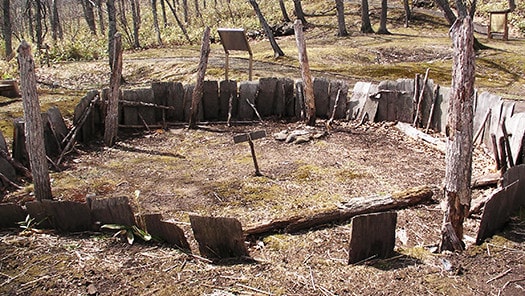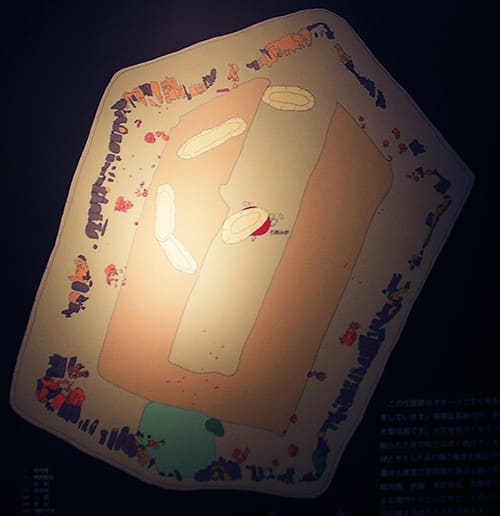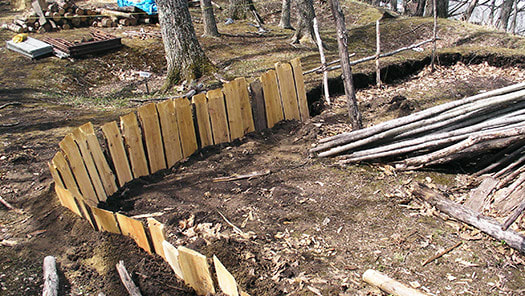


北海道北見市常呂町に残る「ところ遺跡」には約4,000年前頃からの竪穴住居痕跡が残っている。最後の「擦文文化期」が約1,000年前ということで延べ3,000年間の先人の痕跡。
住の側面からみると、一貫して「竪穴住居」が建てられて人間活動の基盤になってきた。竪穴はいわば北海道における人類文化の「ゆりかご」と言えるだろう。こちらの遺跡では訪問時・2009年には竪穴住居の再建プロセスを見学することが出来た。この遺跡全体は東京大学が長年発掘調査を行ってきている。その研究成果に基づいて「工法」が解析されたと思われる。
竪穴という住環境は、その地域の「凍結深度」〜そのレベルまで土壌が凍結してしまう深さ〜よりも掘り下げた地盤面を住空間の床面とすることで、その地域の「年間平均気温」レベルの安定した「地熱」環境を獲得することができるとされる。
とくに寒冷地にあってはなによりも年間を通しての「室内気候」の安定が最重視されただろうことは論を待たないだろう。年平均気温は札幌では8.9度程度とされるが、北見市常呂では5度前後。その地熱に対して常時燃焼させる囲炉裏の加熱と萱状植物による保温で生活環境を確保した。
このような現代科学の生活環境知見それ自体が過去の人びとに共有されていたわけではないけれど、いわば北国環境に対応する「人類経験知」として、このような住環境を獲得してきたのだろう。わたしが見た中では、同じオホーツク圏の標津でみた復元住居では1m近い深さのものもあった。
こちらの遺跡ではこの竪穴掘削について、その手法として、木材で地面外周を柵のように囲ませて、その内側部分を住居内部と特定して、地面を「掘り下げていく」手法が提示されていた。掘り下げられた後には「土留め」としても機能した。
ここでの木柵の板状素材は現代的な工具での造作が施されていたけれど、もちろん建てられた当時にはもう少し粗放な手法で板状加工が施された木材が使われたことだろう。石器の斧で木割りしたか。
この遺跡環境は「やや高台」という立地で、土壌それ自体は掘削に適したやわらかな土壌だっただろうと推定される。そういった竪穴住居建築に適した地形の選定にも、太古以来の人類知が大いに発揮されたのだろう。もちろん基本生業としての狩猟採集、定住的な環境での採取が可能なサケマス漁に適していて、その余録として山野の動物性タンパク源があったのだろう。サケマスは、乾燥させることで一年を通しての安定的な食糧とすることが出来た。
こういう竪穴を掘る作業は、相当の労役作業だったと推測できる。竪穴1戸あたり10人程度の同居人数が想定されていたけれど、常時ムラとしては3軒ほどの竪穴式住居があったとされるので、人口規模は30人程度。労働可能人口を考えれば、1戸の家を建てる営為はムラ社会の一大事業だったと思われる。
English version⬇
The construction of the pit dwelling and foundation perimeter - Tokoro Site-2
In a society of 30 mura members, the labor work of “digging” a pit dwelling is a major undertaking. It was a major undertaking for a society of 30 mura members to “dig” a pit dwelling, and it would have been a significant public benefit to know how the technique was passed on to future generations. The site of the
The “Tokoro Site” in Tokoro Town, Kitami City, Hokkaido, contains traces of pit dwellings dating from around 4,000 years ago. The last “Abrasive Culture Period” was about 1,000 years ago, which means the traces of the predecessors for a total of 3,000 years.
From the aspect of housing, “pit dwellings” have consistently been built to serve as the foundation of human activities. The pit can be said to be the “cradle” of human culture in Hokkaido. When we visited this site in 2009, we were able to observe the reconstruction process of the pit dwellings. The University of Tokyo has been excavating the entire site for many years. The “construction method” seems to have been analyzed based on the results of that research.
It is said that a stable geothermal environment at the level of the average annual temperature of the region can be obtained in a pit dwelling by excavating the ground surface lower than the “freezing depth” of the region (the depth at which the soil freezes to that level) and using it as the floor surface of the dwelling space.
Especially in cold regions, it is arguable that the most important thing is to have a stable indoor climate throughout the year. The average annual temperature in Sapporo is said to be around 8.9 degrees Celsius, while in Tokoro, Kitami City, it is around 5 degrees Celsius. The living environment was secured by the constant heat from the geothermal heat from the hearth and the use of heath plants to retain heat.
This kind of modern scientific knowledge of the living environment itself was not shared by the people of the past, but it is likely that they acquired this kind of living environment as “human experiential knowledge” to cope with the northern environment. Among the restored dwellings I saw in Shibetsu, also in the Okhotsk region, some were nearly one meter deep.
At this site, the pit excavation method used was to enclose the perimeter of the ground with wood like a fence, identify the inner part of the fence as the interior of the dwelling, and “dig down” into the ground. After being dug down, it also functioned as an “earth retaining” structure.
The plank material of the wooden fence here was worked with modern tools, but of course, at the time of its construction, the wood would have been planked with a more crude technique. Was the wood split with a stone axe?
The site is located on a “slightly elevated plateau,” and the soil itself is presumed to have been soft and suitable for excavation. The selection of such a topography suitable for pit house construction must have been made possible by the knowledge of mankind since ancient times. Of course, it was suitable for hunting and gathering as a basic livelihood and for fishing for salmon trout, which can be collected in a sedentary environment, and the animal protein source in the mountains and fields would have been an additional record of such fishing. Salmon trout could be dried to provide a stable food source throughout the year.
It can be assumed that the work of digging these pits was quite labor intensive. It was assumed that there were about 10 people living together in each pit, but since there were always about three pit houses in a village, the population size was about 30 people. Considering the workable population, the construction of a single house would have been a major undertaking for a mura society.

















